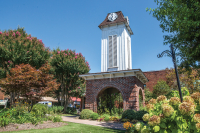Jackson leaders plan for growing court needs
 The start of business Thursday, Dec. 10, will mean the coming-to-order of five different court sessions in Jackson County, a giant figure for a county with only two actual courtrooms at its disposal. To meet demand, courts will be squirreled away wherever there’s space — in the commissioners’ boardroom, in the county law library, in the old courtroom that’s now the community room of the Jackson County Library.
The start of business Thursday, Dec. 10, will mean the coming-to-order of five different court sessions in Jackson County, a giant figure for a county with only two actual courtrooms at its disposal. To meet demand, courts will be squirreled away wherever there’s space — in the commissioners’ boardroom, in the county law library, in the old courtroom that’s now the community room of the Jackson County Library.
Though the county’s stuck with stop-gap measures for that week in December — four courts per day are scheduled for Dec. 7-9, five for Dec. 10 and two for Friday, Dec. 11 — commissioners are trying to figure out a more permanent solution. They have to, because Superior Court Judge Bradley Letts has told them they have to. In North Carolina, counties are responsible for providing adequate court facilities, and judges have the authority to decide whether a facility is adequate or not.
“He (Letts) has pointed out the fact that two courtrooms just are not serving the needs of Jackson County,” County Manager Chuck Wooten said, paraphrasing a directive Letts has expressed multiple times over the past couple of years.
Jackson County has just two courtrooms in its more than 20-year-old building, and increasingly that space is coming up short. According to court schedules, 2013, 2014 and 2015 all had three days in which three or more courts were scheduled on the same day, exceeding the capacity of the two-courtroom building. Dec. 10 takes the prize for most courts scheduled in a day, with five.
The question of space is now entering the realm of immediate need rather than of future possibility. Commissioners have to decide what to do about it.
“If we can find a way to come up with a third space that could buy us enough time — six, seven, eight years — then we can figure out what we’re going to do permanently,” Commission Chairman Brian McMahan said at the commissioners’ November work session.
Related Items
As of now, that’s what commissioners are talking about most seriously — not, as suggested in a study the former board commissioned from Heery International last year, that they build an extra 36,000 square feet of space.
“Is it more cost-effective to build a judicial building than it is to take this space and convert it? That’s one of the things that needs to be looked at,” Wooten said.
It makes sense that the courts need more space, Commissioner Mark Jones said, because the county itself has grown. Between 2000 and 2010 alone, the county’s population grew by 21.6 percent, according to U.S. Census data. And between 2010 and 2014, the population grew an estimated 1.8 percent. Today, 7,860 more people live in Jackson County than lived there in 2000, census data says, and more people need more services of all kinds, including court-related ones.
Of course, the court schedule doesn’t necessarily line up with actual court use. Sometimes a court session scheduled to take four days finishes up in three, or sometimes the same judge is responsible for multiple court sessions in a day and so is able to consolidate.
On the other hand, the county’s court space experiences demands not reflected on the court schedule. Most Wednesdays, the magistrate judge needs a courtroom, and the clerk of court often resorts to using her office for the cases she handles — not the most secure situation.
And it’s not just about the courtrooms themselves. A well-designed courthouse includes space for juries to assemble and attorneys to meet. It has triplicate elevators and passages to keep juries, opposing parties and the public separate.
“Courthouses are unique,” Letts said. “They’re like a hospital or a jail. You just need to do unusual things you wouldn’t do in a normal building.”
Looking for a workaround
But commissioners sounded loath to get behind the $10 million-plus addition Heery had suggested in 2014, with the conversation instead centering around possibilities to make the existing space work.
For example, if the county builds a new Health Department building — another capital need commissioners have been discussing — then they could make space in the existing justice center by moving administrative offices out of that building.
“If we can relocate code enforcement, building inspection, all those folks down there (the existing Health Department building) — even relocate planning so we’ve got code enforcement and planning all in one location — that frees up that whole corridor downstairs with the exception of tax. Then you can move tax collections upstairs to where planning was right next to finance,” McMahan said by way of suggestion. “The whole bottom floor can be converted for court.”
Dietz concurred with that way of thinking, indicating that he wouldn’t support a new justice center building and expected constituents wouldn’t either.
“If we start telling people we have to build a new one, that’s not going to go over real well,” he said.
“I can’t say it goes over with me real well, either,” Commissioner Vicki Greene agreed.
Commissioners came to a consensus that Wooten should start talking to Heery — the same company that planned and built the new Haywood County courthouse — about getting together a proposal for creating extra space in the justice center, but that solutions should concentrate on commissioners’ desire to work with what they’ve got. That goes for the stop-gap measures they’re looking at to make do for now, too.
“If were going to have to do potential expansion later, let’s not waste money,” McMahan said. “Let’s incorporate into this study to make sure it’s what we need now. We don’t want to build something now and then five years later throw it away.”
For the near future, the county will likely make some changes to its law library and the commissioners’ boardroom so those spaces will be more suitable to holding court. That will buy commissioners the time they need to figure out what to do and how to pay for it.
While that will provide a temporary fix for the space issue, it’s not a permanent solution. Actual court space is only the tip of the iceberg as far as justice center needs are concerned. More courts means more juries, and juries need a separate room to go to for deliberation. More courts also mean more defendants, more plaintiffs, more attorneys and more spectators. Ideally, those groups of people all have their own entrances and exits to the courtroom, preventing conflict when sparring parties cross paths.
In fact, according to the study Heery did last year, even if all non-court-related functions left the building, the Jackson County Justice Center still wouldn’t have enough space to accommodate court needs for the coming years.
This isn’t the first time this year Letts has approached commissioners about shortcomings in the justice center. He appeared at their planning retreat in January to talk about two “issues I’ve been bringing to your attention for 10 years” — space and security. At the time, security was the more pressing issue, with no screening in place at the courthouse and unmonitored entrances and exits throughout the building.
Letts’ request prompted commissioners to approve a single-point-of-entry system for a price tag of $343,000, plus $140,000 annually in salaries for additional security personnel. The system went into effect Sept. 28.









